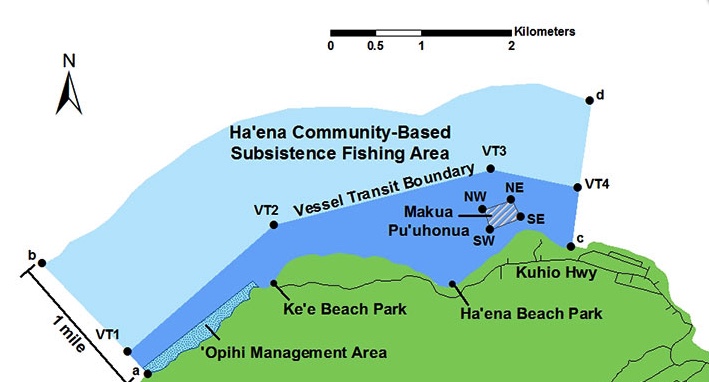
Monitoring confirms it: The Ha‘ena Community-Based Subsistence Fishing Area (CBSFA) works.
In October 2014, the Board of Land and Natural Resources approved rules establishing the area over the objections and a contested case hearing request by commercial fishermen Michael Sur and Makani Christensen. Christensen has occasionally worked for the Western Pacific Fishery Management Council.
The Ha‘ena CBSFA was the first in the state. Its objective was to protect marine resources by prohibiting the sale of any marine life taken from the area (except invasive seaweed) and by strictly limiting the amount of resources removed, as well as the gear used to do it.
At the Land Board’s June 26 meeting, community members, staff with the Department of Land and Natural Resources’ Division of Aquatic Resources (DAR), and University of Hawai‘i scientists provided a five-year status update on the Ha‘ena CBSFA.
According to DAR biologist Heather Ylitalo-Ward, division staff from Maui, O‘ahu and Kaua‘i all helped collect data from the area. Emily Cadiz, program director for Hui Maka‘ainana o Makana, added that her organization developed a community-driven marine monitoring program that looks at the whole watershed. It monitors seasonal trends and cycles, logs catches of local fishermen, determines catch rates, and looks at reproductive organs of fish caught, among many other things, she said.
Every July, the non-profit organization hosts more than 100 families at its workshops, where they learn about sustainable practices, Cadiz said. Since the CBSFA has been established, she said the organization spends more than 10,000 volunteer hours a year engaging the community, particularly its youth. University of Hawai‘i biologist Ku‘ulei Rodgers presented some preliminary results of the collaborative efforts of DAR and UH to determine the efficacy of the Ha‘ena CBSFA’s management plan. Between 2016 and 2019, she said, more than 100 surveys a year have been done for the fish, limu and invertebrates. The results were compared with surveys done in 2013-2014 before the establishment of the CBSFA. Separately, she said, DAR and UH continue coral reef surveys at Limahuli, within the CBSFA reserve, that have been going on for decades.
“In 2016, the first year we compared the results, we found significant differences only in the number of fish. No significant differences in biomass inside and outside the CBSFA,” she said.
But in 2017, she continued, “we found there was a statistically significant increase in fish populations, in biomass, abundance, number of species, and endemic species. … After two years, it appeared the reserve was working as intended.”
She added that long-term monitoring is important because of short-term fluctuations due to bleaching events, storms, or tsunamis.
In April 2018, Ha‘ena experienced a massive flooding event that caused a decline in some fish resources. “We were able to look at these declines and tie them to the freshwater event,” she said, adding that the only species impacted were those in shallow waters.
Despite the decline in some fish factors, in 2019, the fish community continued to increase, she said.
“In summary, when we average data across all four years, there was an increase in fish abundance, number, largest size class and diversity of fish. It is higher inside the CBSFA compared to outside,”she said.
Hui o Maka‘ainana o Makana president Presley Wann said consistent education and enforcement are challenges. “The main problem for us has been consistent community participation,” he said. “It is a volunteer group. Even though we did over 100 informational meetings, we’re still experiencing over-harvesting of limu — trash bags full — spearfishing and night diving.”
He said his organization is working on creating an educational website and on getting a full-time Makai Watch coordinator to organize volunteer monitors. “It is a full-time job,” he said.
He said invasive species are also a concern, particularly the black-lipped tilapia, which “could be one of the greatest threats to our fisheries.”
Last year, the group, along with Moloka‘i’s Hui Malama o Mo‘omomi, received the prestigious Equator Prize for their work on resiliency in the face of climate change. Wann said that the international award has led to a lot of different funding organizations wanting to help out. “Where we’re lacking now is education. We don’t want to burden DOCARE [the DLNR’s Division of Conservation and Resources Enforcement]. We want to educate, rather than enforce,” he said.
Maui Land Board member Jimmy Gomes thanked Wann for his group’s hard work, which also includes helping manage sites within Ha‘ena State Park. Gomes asked if the group’s key people could help efforts to establish a CBSFA at Mo‘omomi.
In 2018, the Land Board approved a request by DAR to hold public hearings on a CBSFA at Mo‘omomi, the creation of which was led by Hui Malama o Mo‘omomi. But because of opposition from state Rep. Lynn DeCoite and a number of commercial and recreational fishers, the process stalled.
“There is so much pushback from our representative DeCoite [and others.] … Any kind of help we can get to educate that community there would be greatly appreciated,” Gomes said.
Wann said he planned to attend meetings on the Mo‘omomi CBSFA. “All we do is when we go there, we’re not going to be there to tell them what to do, [but just] tell them what works for Ha‘ena. In Ha‘ena, it is working,” he said.
“Right now, they’re the model for Hawai‘i. They’re a great model. Every island is looking toward them,” said Kaua‘i Land Board member Tommy Oi.
DAR administrator Brian Neilson said the planned public hearings on the Mo‘omomi CBSFA had to be postponed because of the COVID-19 pandemic, but have been rescheduled for mid-August. The public will be able to participate in a virtual format or in person, in a socially distant way, he said.
— Teresa Dawson

Leave a Reply